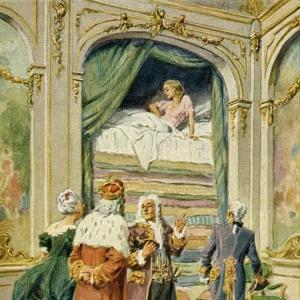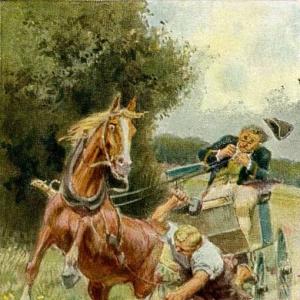Reading time: 11 min
This story, my dear young folks, seems to be false, but it really is true, for my grandfather, from whom I have it, used always, when relating it, to say complacently, „It must be true, my son, or else no one could tell it to you.“ The story is as follows. One Sunday morning about harvest time, just as the buckwheat was in bloom, the sun was shining brightly in heaven, the east wind was blowing warmly over the stubble-fields, the larks were singing in the air, the bees buzzing among the buckwheat, the people were all going in their Sunday clothes to church, and all creatures were happy, and the hedgehog was happy too. The hedgehog, however, was standing by his door with his arms akimbo, enjoying the morning breezes, and slowly trilling a little song to himself, which was neither better nor worse than the songs which hedgehogs are in the habit of singing on a blessed Sunday morning. Whilst he was thus singing half aloud to himself, it suddenly occurred to him that, while his wife was washing and drying the children, he might very well take a walk into the field, and see how his turnips were going on. The turnips were, in fact, close beside his house, and he and his family were accustomed to eat them, for which reason he looked upon them as his own. No sooner said than done. The hedgehog shut the house-door behind him, and took the path to the field. He had not gone very far from home, and was just turning round the sloe-bush which stands there outside the field, to go up into the turnip-field, when he observed the hare who had gone out on business of the same kind, namely, to visit his cabbages. When the hedgehog caught sight of the hare, he bade him a friendly good morning.
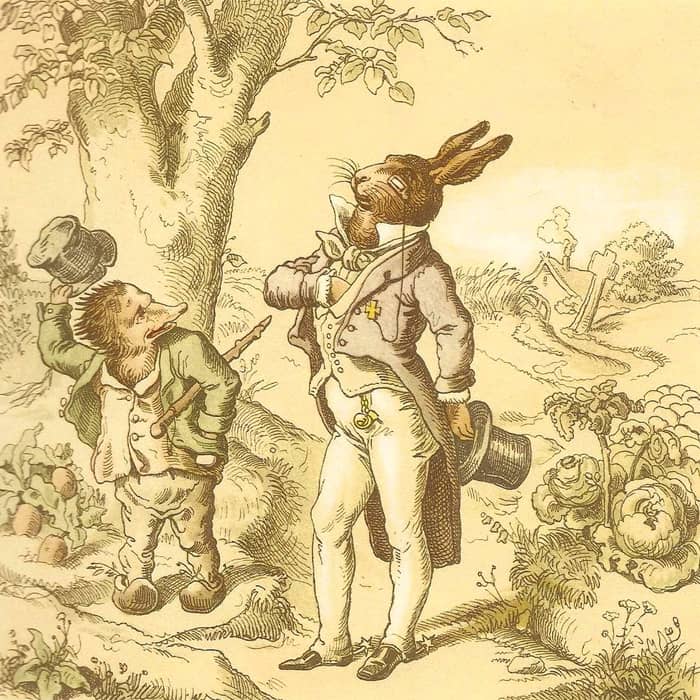
But the hare, who was in his own way a distinguished gentleman, and frightfully haughty, did not return the hedgehog’s greeting, but said to him, assuming at the same time a very contemptuous manner, „How do you happen to be running about here in the field so early in the morning?“ – „I am taking a walk,“ said the hedgehog. „A walk!“ said the hare, with a smile. „It seems to me that you might use your legs for a better purpose.“ This answer made the hedgehog furiously angry, for he can bear anything but an attack on his legs, just because they are crooked by nature. So now the hedgehog said to the hare, „You seem to imagine that you can do more with your legs than I with mine.“ – „That is just what I do think,“ said the hare. „That can be put to the test,“ said the hedgehog. „I wager that if we run a race, I will outstrip you.“ – „That is ridiculous! You with your short legs!“ said the hare, „but for my part I am willing, if you have such a monstrous fancy for it. What shall we wager?“ – „A golden louis-d’or and a bottle of brandy,“ said the hedgehog. „Done,“ said the hare. „Shake hands on it, and then we may as well come off at once.“ – „Nay,“ said the hedgehog, „there is no such great hurry! I am still fasting, I will go home first, and have a little breakfast. In half-an-hour I will be back again at this place.“
Hereupon the hedgehog departed, for the hare was quite satisfied with this. On his way the hedgehog thought to himself, „The hare relies on his long legs, but I will contrive to get the better of him. He may be a great man, but he is a very silly fellow, and he shall pay for what he has said.“ So when the hedgehog reached home, he said to his wife, „Wife, dress thyself quickly, thou must go out to the field with me.“ – „What is going on, then?“ said his wife. „I have made a wager with the hare, for a gold louis-d’or and a bottle of brandy. I am to run a race with him, and thou must be present.“ – „Good heavens, husband,“ the wife now cried, „art thou not right in thy mind, hast thou completely lost thy wits? What can make thee want to run a race with the hare?“ – „Hold thy tongue, woman,“ said the hedgehog, „that is my affair. Don’t begin to discuss things which are matters for men. Be off, dress thyself, and come with me.“ What could the hedgehog’s wife do? She was forced to obey him, whether she liked it or not.
So when they had set out on their way together, the hedgehog said to his wife, „Now pay attention to what I am going to say. Look you, I will make the long field our race-course. The hare shall run in one furrow, and I in another, and we will begin to run from the top. Now all that thou hast to do is to place thyself here below in the furrow, and when the hare arrives at the end of the furrow, on the other side of thee, thou must cry out to him, ‚I am here already!'“
Then they reached the field, and the hedgehog showed his wife her place, and then walked up the field. When he reached the top, the hare was already there. „Shall we start?“ said the hare. „Certainly,“ said the hedgehog. „Then both at once.“ So saying, each placed himself in his own furrow. The hare counted, „Once, twice, thrice, and away!“ and went off like a whirlwind down the field. The hedgehog, however, only ran about three paces, and then he stooped down in the furrow, and stayed quietly where he was. When the hare therefore arrived in full career at the lower end of the field, the hedgehog’s wife met him with the cry, „I am here already!“
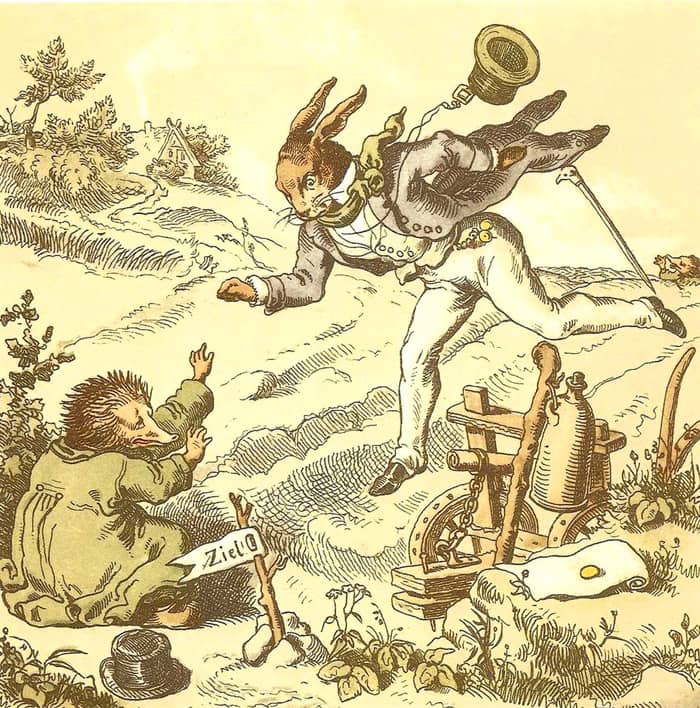
The hare was shocked and wondered not a little, he thought no other than that it was the hedgehog himself who was calling to him, for the hedgehog’s wife looked just like her husband. The hare, however, thought to himself, „That has not been done fairly,“ and cried, „It must be run again, let us have it again.“ And once more he went off like the wind in a storm, so that he seemed to fly. But the hedgehog’s wife stayed quietly in her place. So when the hare reached the top of the field, the hedgehog himself cried out to him, „I am here already.“ The hare, however, quite beside himself with anger, cried, „It must be run again, we must have it again.“ – „All right,“ answered the hedgehog, „for my part we’ll run as often as you choose.“ So the hare ran seventy-three times more, and the hedgehog always held out against him, and every time the hare reached either the top or the bottom, either the hedgehog or his wife said, „I am here already.“
At the seventy-fourth time, however, the hare could no longer reach the end. In the middle of the field he fell to the ground, blood streamed out of his mouth, and he lay dead on the spot. But the hedgehog took the louis-d’or which he had won and the bottle of brandy, called his wife out of the furrow, and both went home together in great delight, and if they are not dead, they are living there still.
This is how it happened that the hedgehog made the hare run races with him on the Buxtehuder heath till he died, and since that time no hare has ever had any fancy for running races with a Buxtehuder hedgehog.
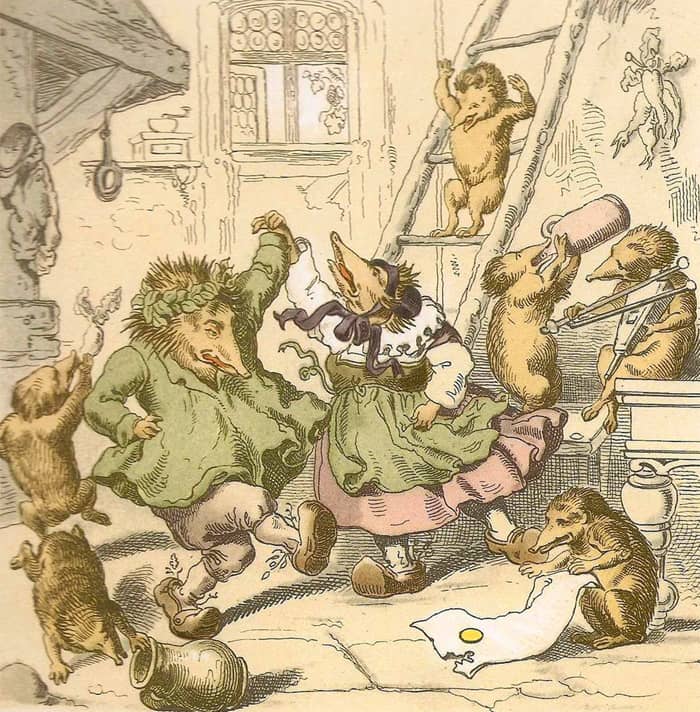
The moral of this story, however, is, firstly, that no one, however great he may be, should permit himself to jest at any one beneath him, even if he be only a hedgehog. And, secondly, it teaches, that when a man marries, he should take a wife in his own position, who looks just as he himself looks. So whosoever is a hedgehog let him see to it that his wife is a hedgehog also, and so forth.
 Learn languages. Double-tap on a word.Learn languages in context with Childstories.org and Deepl.com.
Learn languages. Double-tap on a word.Learn languages in context with Childstories.org and Deepl.com.Backgrounds
Interpretations
Adaptions
Summary
Linguistics
„The Hare and the Hedgehog“ is a German fairy tale collected by the Brothers Grimm, Jakob and Wilhelm, who were prominent linguists and cultural researchers in the early 19th century. They collected and published numerous folk tales and fairy tales from various regions of Germany, aiming to preserve the rich storytelling traditions of their time. The collection, first published in 1812 under the title „Children’s and Household Tales“ (Kinder- und Hausmärchen), has become a cornerstone of Western literature.
The Brothers Grimm were part of the German Romanticism movement, which sought to preserve and promote the cultural heritage of their country, while also reflecting on universal themes of morality and human nature. The stories they collected often include fantastical elements, talking animals, and moral lessons. Many of the Grimm brothers‘ tales, including „The Hare and the Hedgehog,“ have been adapted and retold in various forms throughout the years, including children’s literature, theater, and film.
„The Hare and the Hedgehog“ is set in the region of Buxtehude, a historic town in Lower Saxony, Germany. The story portrays the importance of humility, wit, and choosing a compatible partner, while cautioning against arrogance and overconfidence. Although it might seem like an unlikely tale, the story’s charm and moral lessons have made it a classic in the world of fairy tales.
There are several interpretations one can draw from „The Hare and the Hedgehog“:
The importance of humility: The hare, full of pride and arrogance, underestimated the hedgehog, which ultimately led to its downfall. The story teaches that being humble and respecting others, regardless of their appearance or status, is essential.
The value of wit and strategy: The hedgehog, aware of his physical limitations, cleverly devised a plan to outsmart the hare. This highlights the importance of using one’s intellect and strategic thinking to overcome challenges and turn weaknesses into strengths.
The power of teamwork: The hedgehog’s wife played a crucial role in ensuring their victory. This demonstrates the importance of collaboration and support from loved ones to achieve success.
The dangers of overconfidence: The hare’s overconfidence blinded it to the hedgehog’s cunning plan, resulting in its defeat and eventual death. The story serves as a reminder not to become overly confident in one’s abilities and to always be vigilant and cautious.
The significance of choosing a compatible partner: The tale also emphasizes the importance of selecting a spouse who shares one’s appearance, status, and values. The hedgehog’s wife was instrumental in their victory because she was able to seamlessly assume her husband’s role in the race, highlighting the benefits of compatibility in a relationship.
„The Hare and the Hedgehog“ has been adapted into various forms of media over the years, including books, films, and even operas. Here are some notable adaptations:
„The Hare and the Hedgehog“ (1954): This animated short film by Lotte Reiniger tells the story of the hare and the hedgehog using silhouette animation. It won several awards at film festivals around the world.
„The Adventures of Ichabod and Mr. Toad“ (1949): This Disney animated film features a retelling of „The Wind in the Willows“ and „The Legend of Sleepy Hollow,“ but it also includes a segment based on „The Hare and the Hedgehog.“
„The Hare and the Hedgehog“ (1982): This West German film is a live-action adaptation of the story. It features a cast of human actors playing the animals in the story, using costumes and animatronic puppets.
„The Hare and the Hedgehog“ (1993): This German animated film is a faithful retelling of the original story. It uses hand-drawn animation and was released in both German and English-language versions.
„The Hare and the Hedgehog“ (2016): This animated short film by Joanna Lurie tells the story of the hare and the hedgehog using minimalist animation and a haunting musical score.
„The Hare and the Hedgehog“ (opera): This opera by composer Giselher Klebe was first performed in 1963. It tells the story of the hare and the hedgehog through music and lyrics.
Overall, „The Hare and the Hedgehog“ has proven to be a popular and enduring story that has been adapted into various forms of media over the years. Its simple yet powerful message continues to resonate with audiences of all ages.
„The Hare and the Hedgehog“ by the Brothers Grimm tells the story of a humble hedgehog who challenges a haughty hare to a race. The story begins one Sunday morning as the hedgehog is enjoying a peaceful moment outside his home. He decides to check on his turnips, and on the way, he encounters the hare, who ridicules the hedgehog’s legs. Furious, the hedgehog challenges the hare to a race for a gold coin and a bottle of brandy.
The hedgehog cunningly asks his wife, who looks just like him, to help him win the race. They agree that she will wait at the end of the field while the hedgehog starts the race with the hare. When the hare reaches the end, the hedgehog’s wife claims to have arrived there first. The confused hare demands a rematch. This continues seventy-three more times, with the hare losing every race, until he ultimately collapses and dies from exhaustion.
The hedgehog and his wife celebrate their victory and enjoy their prize, while the story teaches two morals. Firstly, it warns against mocking or underestimating others, regardless of their status. Secondly, it encourages marrying someone similar in appearance and status. Since the hedgehog’s victory, no hare has dared to race a hedgehog from Buxtehude.
The fairy tale „The Hare and the Hedgehog,“ collected by the Brothers Grimm, offers a variety of insights when examined through a linguistic and thematic lens. This analysis will focus on the narrative structure, themes, characters, and linguistic devices that contribute to the overall moral and humor of the story.
Structural Analysis
The story follows a classic fairy-tale structure, beginning with a scene-setting exposition and culminating in a moral lesson. It opens by establishing a serene pastoral setting, typical of many Grimm tales, before introducing the protagonist, the hedgehog, and his antagonist, the hare. The narrative is linear, progressing through a sequence of events that lead directly to the climax—the hare’s collapse and the hedgehog’s victory—and concluding with the moral.
Thematic Elements
Social Critique and Satire:
The story serves as a satire of social hierarchies and the folly of underestimating those of a lower perceived status. The hare’s arrogance and mockery of the hedgehog represent societal attitudes that value superficial traits—such as speed or physical prowess—over cunning and wit. The tale critiques those who are „frightfully haughty“ and „distinguished gentlemen“ who look down upon others.
Deception and Wit:
The hedgehog’s victory is achieved through cleverness rather than physical ability, promoting the theme that intelligence can triumph over brute force. The interchangeability of the hedgehog and his wife signifies the importance of teamwork and collaboration in overcoming challenges.
Marriage and Partnership:
The story subtly critiques traditional gender roles and assumptions through the hedgehog’s partnership with his wife. Her willingness to participate in the ruse speaks to the importance of marital partnership founded on shared goals and mutual understanding. The moral underscores the value of marrying within one’s social class or community, as it ensures unity in appearance and intent.
Character Analysis
The Hedgehog:
Portrayed as resourceful and strategic, the hedgehog embodies the archetype of the clever underdog. Despite being underestimated, he uses the hare’s assumptions against him. His repeated victories over the hare signify the triumph of intellect and perseverance over arrogance.
The Hare:
The hare represents arrogance and superficial judgment, traits that ultimately lead to his downfall. His insistence on proving his superiority blinds him to the hedgehog’s cunning, exemplifying how hubris can lead to self-destruction.
The Hedgehog’s Wife:
Though a secondary character, she plays a crucial role in the hedgehog’s success. Her ability to impersonate her husband highlights themes of unity and deception, as well as the narrative’s critique of gender roles.
Repetition:
The repeated races create a rhythmic narrative pattern, emphasizing the hare’s stubbornness and the futility of his efforts. This repetition also builds tension and humor, as the outcome becomes increasingly inevitable.
Dialogue:
The dialogue between the hedgehog and the hare highlights their contrasting attitudes. The hedgehog’s polite yet firm responses contrast the hare’s dismissive remarks, underscoring the social commentary on arrogance and humility.
Irony:
The use of irony is prevalent, particularly in the hare’s belief in his inevitable victory. The hedgehog’s seemingly absurd challenge and subsequent triumph illustrate situational irony, where the expected outcome is inverted.
Conclusion
„The Hare and the Hedgehog“ is rich with social commentary, humor, and moral lessons. Through its clever use of language and character dynamics, the tale advocates for humility, the value of intelligence over physical prowess, and the importance of marrying within one’s social status. These themes, woven seamlessly into the narrative, offer timeless insights that extend beyond the simple pastoral setting of the story.
Information for scientific analysis
Fairy tale statistics | Value |
|---|---|
| Number | KHM 187 |
| Aarne-Thompson-Uther-Index | ATU Typ 275A |
| Translations | DE, EN, ES, FR, PT, HU, IT, JA, NL, PL, RO, RU, TR, VI, ZH |
| Readability Index by Björnsson | 30.8 |
| Flesch-Reading-Ease Index | 80.7 |
| Flesch–Kincaid Grade-Level | 6.5 |
| Gunning Fog Index | 9.7 |
| Coleman–Liau Index | 7.6 |
| SMOG Index | 9.3 |
| Automated Readability Index | 6.3 |
| Character Count | 7.185 |
| Letter Count | 5.454 |
| Sentence Count | 76 |
| Word Count | 1.373 |
| Average Words per Sentence | 18,07 |
| Words with more than 6 letters | 175 |
| Percentage of long words | 12.7% |
| Number of Syllables | 1.749 |
| Average Syllables per Word | 1,27 |
| Words with three Syllables | 86 |
| Percentage Words with three Syllables | 6.3% |
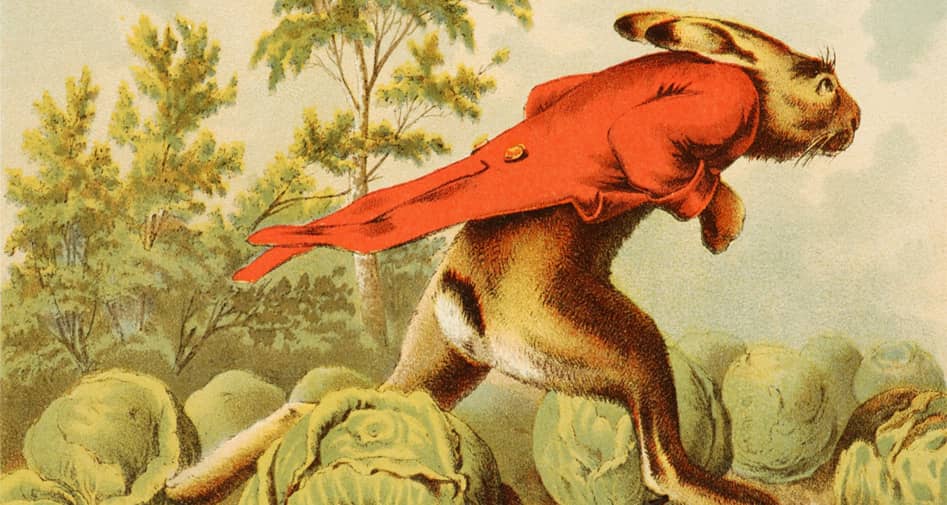
 Facebook
Facebook  Whatsapp
Whatsapp  Messenger
Messenger  Telegram
Telegram Reddit
Reddit